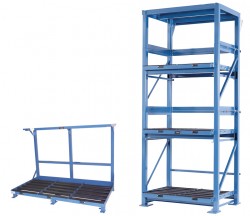We use cookies to make your experience better. To comply with the new e-Privacy directive, we need to ask for your consent to set the cookies. Learn more.
Optimizing Vertical Space in the Forklift Battery Room

Battery rooms can contribute to sustainable expansion by maintaining a constant footprint, regardless of how quickly the battery fleet grows. A 2008 survey by Cranfield University found that battery rooms make up less than 7 percent of the total floor area of the typical warehouse. In order to stay that small with an increasingly larger fleet, take a cue from traditional pallet racking: maximize storage density with tiered battery stands.
Of course, forklift batteries aren't pallets, and they come with their own set of challenges. Here are a few considerations to keep in mind when transitioning from floor-level battery stands to a multi-stack system.
-
High Stands, Heavy Loads
- Forklift batteries are incredibly heavy, easily weighing 3 thousand pounds or more. That's great for providing lift trucks with ballast for heavy loads, but all that weight requires a storage system that's built to safely withstand the treatment.
BHS Double, Triple, and Quad Stack System Stands feature heavy duty steel construction to easily support forklift batteries of any size. Welded system feet enhance stability, providing longstanding reliable performance.
-
Watch for Falling Electrolyte
- Forklift batteries sometimes leak acidic electrolyte, even when they're properly maintained. Make sure to install drip pans beneath each level of battery stands to prevent corrosive build-up, and choose stands that are coated in an acid-resistant finish (like all models of BHS Battery and Charger Stands.)
-
Forklift Battery Chargers Included
- Batteries aren't the only equipment that take up space in the battery room. Forklift battery chargers also require storage, and in a multi-tiered system, it's best to incorporate them directly into the stack. BHS System Stands provide several configurations of charger shelves, built right into the system for the best possible use of space.
-
Don't Forget the Cables
- The more batteries and chargers you have in your collection, the more important cable management becomes. In order to keep charger cables out of the paths of lift trucks and forklift battery changers, take advantage of the cable routing holes included in every BHS System Stand. For even more protection (and added ergonomic benefits for workers), attach Cable Retractors to each charger stand.
The demand for warehouse space continues to grow. As of July of this year, Bureau of Labor Statistics surveys show that warehousing has generated almost 30 thousand more jobs compared to the previous year. More employees means more lift trucks in your fleet and more batteries to store in your forklift battery room.
There are other options for the growing operation, of course. You could build additional wings onto your warehouse, or even rent additional storage space off-site. These solutions may work for some operations, but for the typical warehouse, the most cost-effective way to grow isn't outwards — it’s upwards.
References:
“2003 Commercial Buildings Energy Consumption Survey: Table A6. Building Size, Floorspace for All Buildings (Including Malls).” eia. U.S. Energy Information Administration, Dec. 2006. Web. 19 Aug. 2015.
“2012 Commercial Buildings Energy Consumption Survey: Table B20. Number of Establishments in Building, Floorspace, 2012.” eia. U.S. Energy Information Administration, Apr. 2015. Web. 19 Aug. 2015.
“Employment, Hours, and Earnings from the Current Employment Statistics Survey (National): Warehousing and Storage.” bls. Bureau of Labor Statistics, United States Department of Labor, Aug. 2015. Web. 19 Aug. 2015.
Richards, Gwynne. Warehouse Management : A Complete Guide To Improving Efficiency And Minimizing Costs In The Modern Warehouse. London: Kogan Page, 2011. eBook Collection (EBSCOhost). Web. 19 Aug. 2015.
